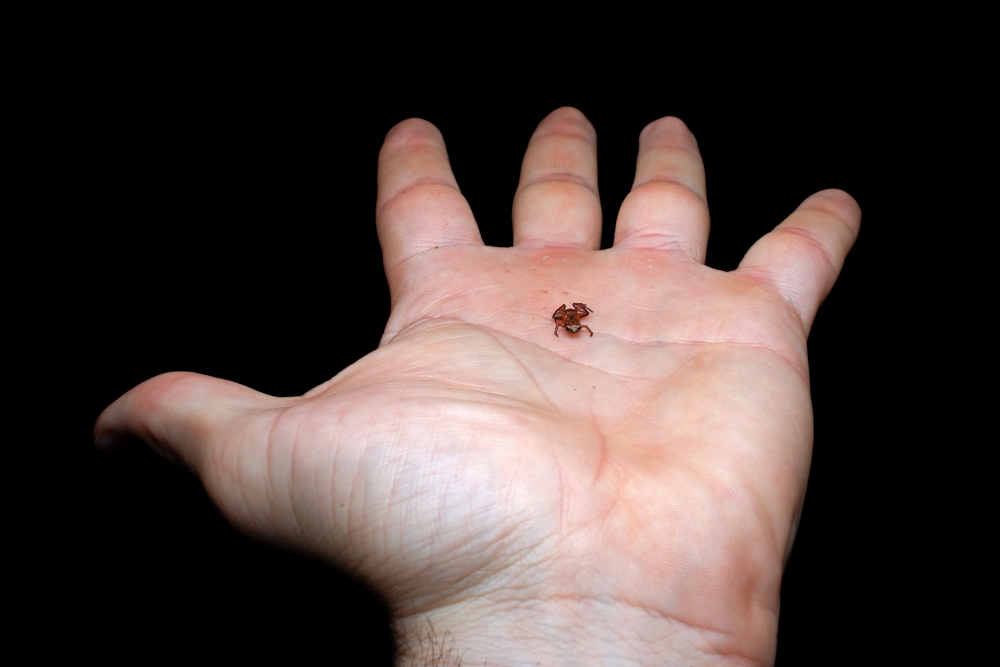

New miniature species on researcher’s palm (photo: Lucas Machado Botelho/Projeto Dacnis)
Brachycephalus dacnis is the seventh species of flea toad identified and is larger only than an individual of a closely related species found in southern Bahia state, Brazil. The study published in PeerJ was led by a group at the State University of Campinas.
Brachycephalus dacnis is the seventh species of flea toad identified and is larger only than an individual of a closely related species found in southern Bahia state, Brazil. The study published in PeerJ was led by a group at the State University of Campinas.

New miniature species on researcher’s palm (photo: Lucas Machado Botelho/Projeto Dacnis)
By André Julião | Agência FAPESP – A group led by researchers affiliated with the State University of Campinas (UNICAMP) in São Paulo state, Brazil, has just published a description of the second-smallest vertebrate in the world. One of the specimens of the miniature toad used in the study, an adult, is only 6.95 mm in length. Another research group previously described an 6.45 mm individual belonging to a different species in the same genus (B. pulex) in the south of Bahia state.
An article on the study, which was supported by FAPESP, is published in the journal PeerJ Life & Environment.
Flea toads, as some species in the genus Brachycephalus are known, are less than 1 cm long in adulthood. Its size is far smaller than a fingernail or a 50 cent (50p) coin.

Flea toad Brachycephalus dacnis can be less than 7 mm long (photo: Luís Felipe Toledo/IB-UNICAMP)
The name of the new species, B. dacnis, pays tribute to Project Dacnis, a conservation, research and education NGO that maintains private areas of Atlantic Rainforest, including the one where the animal was found, in Ubatuba, on the coast of São Paulo state.
“There are small toads with all the characteristics of large toads except for their size. This genus is different. During its evolution, it underwent what we biologists call miniaturization, which involves loss, reduction and/or fusion of bones, as well as fewer digits and absence of other parts of their anatomy,” said Luís Felipe Toledo, corresponding author of the article and a professor in the Institute of Biology (IB-UNICAMP).
The study was part of the FAPESP-funded Thematic Project “From the natural history to the conservation of Brazilian amphibians”, and was also supported by FAPESP via a PhD scholarship awarded to Julia Ernetti, a co-author of the article.
This is the seventh species of flea toad described in the genus Brachycephalus. Until recently, the genus was known mainly for brightly colored species with venom, such as the pumpkin toadlets B. rotenbergae, B. ephippium and B. pitanga, but researchers are now particularly interested in the diminutive size of the flea toads.

Flea toad Brachycephalus dacnis in its natural environment (photo: Lucas Machado Botelho/Projeto Dacnis)
Although pumpkin toadlets are larger than flea toads, they have fewer anatomical structures. Curiously, for example, they are unable to hear their own vocalizations due to lack of a tympanic middle ear, as shown by an article by Toledo et al. published in Scientific Reports in 2017.
Diversity
The researchers’ attention was drawn to the newly described species, B. dacnis, by its vocalizations. It has the same morphology as another species, B. hermogenesi. Both have yellowish-brown skin, live in leaf litter, do not have tadpoles but emerge from their eggs as fully formed miniatures of the adult morphology, and occur in the same region. Their calls are different, however.
DNA sequencing confirmed that B. dacnis was indeed a new species. However, a visit to Picinguaba, a district of Ubatuba where the specimens that permitted the description of B. hermogenesi were found, showed that B. dacnis also occurs there.
“There may have been specimens belonging to the new species among those that served as a basis for describing B. hermogenesi in 1998,” Toledo said, suggesting the use of historical DNA sequencing tools to clear up any remaining uncertainty. Historical DNA is obtained from zoological museum and herbarium specimens.
In their description of the new species, besides the requisite anatomical traits, the researchers included information about the skeleton and internal organs, as well as molecular data and details of its vocalizations. Descriptions of new species must include these details in order to distinguish them from others more precisely, given that many are cryptic and cannot be differentiated by external anatomy only.
“The diversity of these miniature frogs may be far greater than we think. Hence the importance of describing as many traits and features as possible, to expedite the description process and get to work on conservation as quickly as possible,” Toledo said.
The article “Among the world’s smallest vertebrates: a new miniaturized flea-toad (Brachycephalidae) from the Atlantic rainforest” is at: dx.doi.org/10.7717/peerj.18265.
Republish
The Agency FAPESP licenses news via Creative Commons (CC-BY-NC-ND) so that they can be republished free of charge and in a simple way by other digital or printed vehicles. Agência FAPESP must be credited as the source of the content being republished and the name of the reporter (if any) must be attributed. Using the HMTL button below allows compliance with these rules, detailed in Digital Republishing Policy FAPESP.





